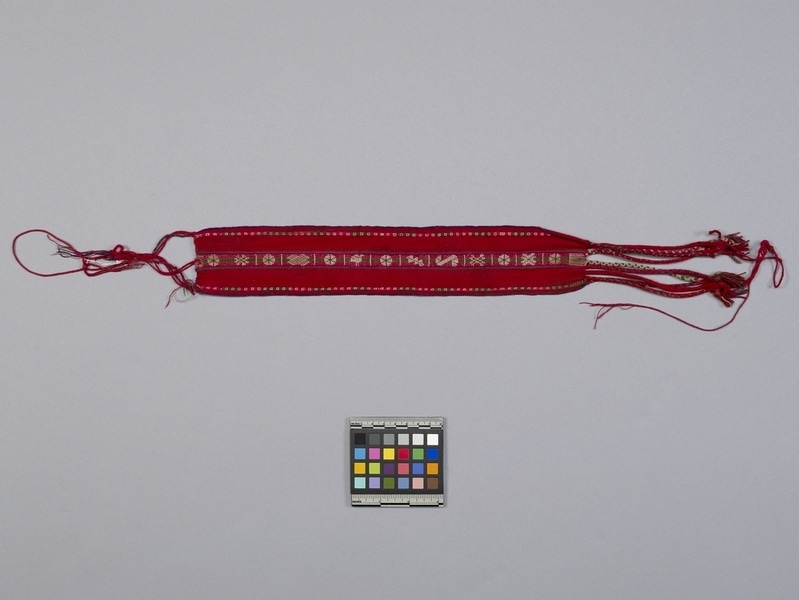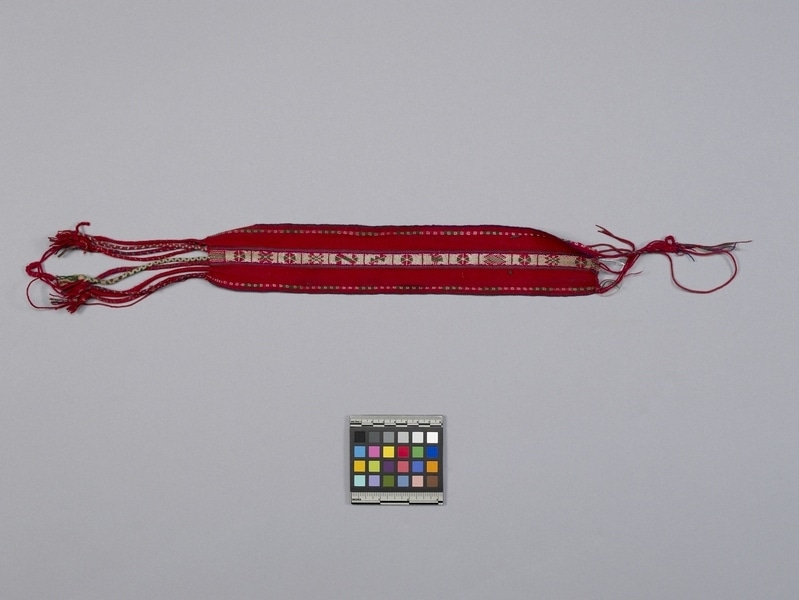Belt Item Number: Sf922 from the MOA: University of British Columbia


Description
Belt with a central band that has a bird motif and geometric motifs of circles, diamonds, crosses and reverse curves in white, red and green and narrow bands of white, green and pink near weft selvedges. One end is finished with nine knotted braids. A re-plied cord is attached to the braids and to the warp selvedges at the other end.
History Of Use
Warp-faced fabrics with three or four selvedges are woven by women but the fabrics, the techniques, structures and some of the motifs have pre-Conquest antecedents. This type of textile conveys the most information about an individual's ethnicity, sex, age, status and particular history. The short length and narrow width distinguishes the belt from adult ones. Used by 4-5 year old boys for fiestas and special occasions.
Cultural Context
special occasion;children
Iconographic Meaning
The range of motifs refers to local geography and landmarks, ecology, fecundity as well as luck. The six part circle refers to the division of land into six sections on Taquile and the rotation of crops and fallow periods.
Narrative
Made by Eufracia Yucra Huatta and used by a young boy.
Specific Techniques
Weave structures are the following: 1-plain colour areas are warp faced plain weave. 2- figurative designs; complementary-warp weave with 3-span floats aligned in alternate pairs with an irregular (abbabaab) warping order (3/1 horizontal colour changes and diagonals of 2-span floats). 3- stripe with squares; float weave derived from turned 2/1 horizontal herringbone with floats forming squares. Commercial 2 ply s yarns are overtwisted in the s direction. The warps in the terminal area are grouped, then braided and knotted. A re-plied cord is attached to the braided ends and the warp selvedge opposite to functions as a tie.
Item History
- Made by Eufrasia Yucra Huatta (Maker) in Taquile, Puno, Peru during 1983
- Collected by Elizabeth L. Johnson during 1984
- Owned by Elizabeth L. Johnson before June 13, 1984
- Received from Elizabeth L. Johnson (Seller) and Museum of Anthropology Shop Volunteers (Funding source) on June 13, 1984
What
Who
- Culture
- Quechua
- Creator
- Eufrasia Yucra Huatta (Maker)
- Field Collector
- Elizabeth L. Johnson
- Previous Owner
- Elizabeth L. Johnson
- Received from
- Elizabeth L. Johnson (Seller) and Museum of Anthropology Shop Volunteers (Funding source)
Where
- Holding Institution
- MOA: University of British Columbia
- Made in
- Taquile, Puno, Peru
When
- Creation Date
- during 1983
- Collection Date
- during 1984
- Ownership Date
- before June 13, 1984
- Acquisition Date
- on June 13, 1984
Other
- Item Classes
- textiles
- Condition
- good
- Accession Number
- 0992/0010